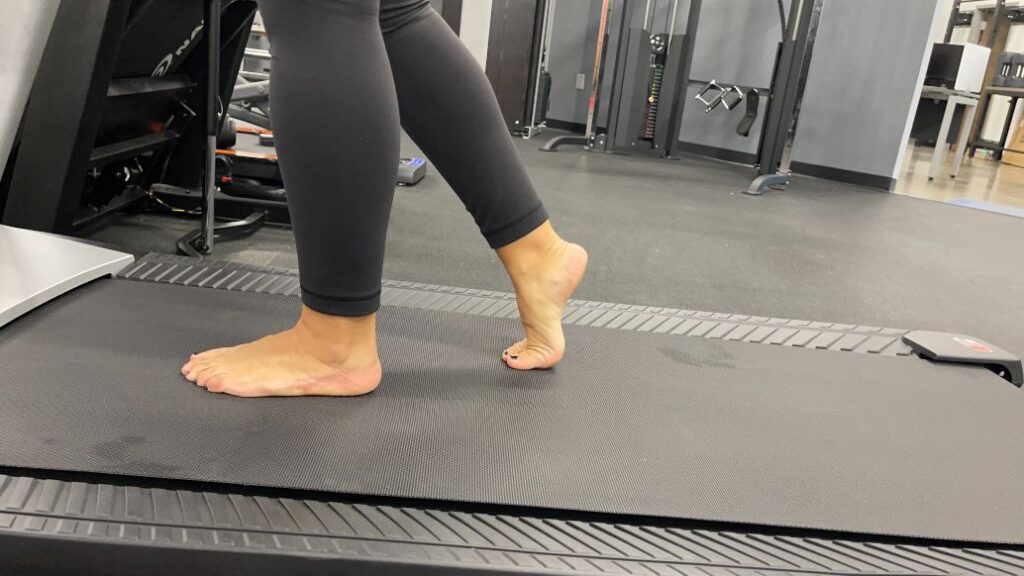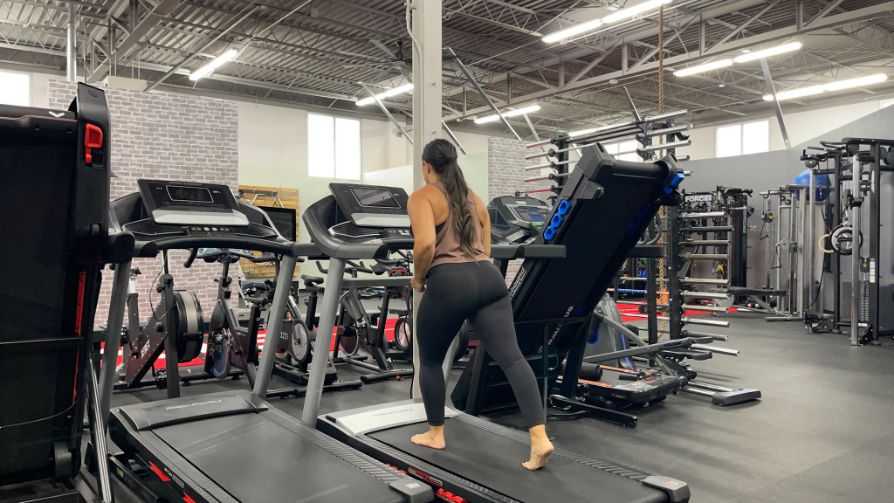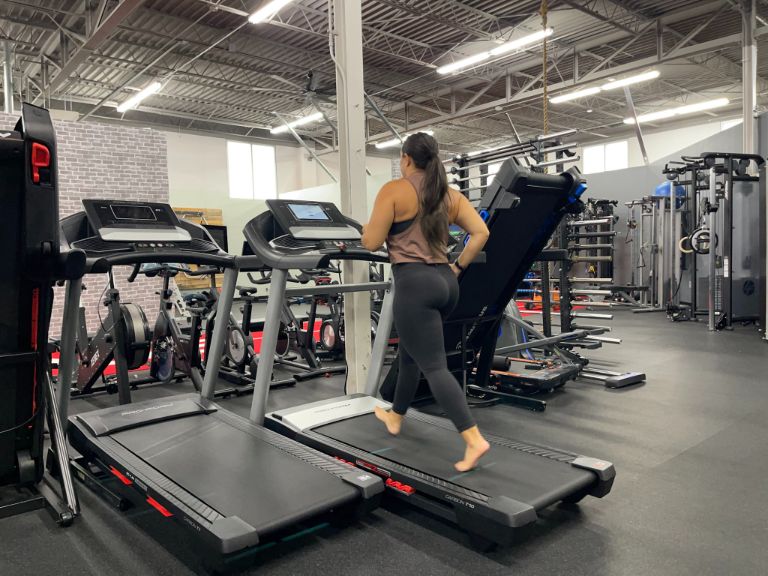We test and review fitness products based on an independent, multi-point methodology. If you use our links to purchase something, we may earn a commission. Read our disclosures.
Barefoot running has been around since the dawn of the humans (literally). But as far as modern movement goes, this cardio trend really picked up steam in the running community in recent decades. There is even a term for running barefoot: “unshod.”
Books like Christopher McDougall’s “Born to Run” popularized the activity, and shoemakers across the globe rushed to launch minimalist options. Today, there are hundreds of clubs in the United States with thousands of members all dedicated to running barefoot. But is running on a treadmill barefoot safe and advantageous? Maybe. Read on to find out more.
Why Would Someone Run Barefoot on a Treadmill?
Minimalist movements have swept across the world, and running is no exception to this. If you’re caught up in this running style, you might consider giving it a go on a treadmill.
Advocates suggest that running barefoot could help you increase your balance and even strengthen muscles in your foot that otherwise go unused. Some people also find running barefoot to be more comfortable and even more fun.
Others claim that going barefoot prompts better running form. However, that may not be true. A 2021 study in the Journal of Biomechanics evaluated 20 experienced runners. Researchers found that running shoes actually don’t have a significant impact on the way we run.

Running Barefoot on a Treadmill: Know the Risks
Even the best treadmills are not designed with the barefoot runner in mind. We’ll get into the disadvantages to general barefoot running below, but we need to look at the specific risks of treadmill running without shoes.
The specific risks of going for a run barefoot on a treadmill include injury. Since you wear shoes mostly all the time in your daily life, the bottoms of your feet can be very tender. When running barefoot on a treadmill, your feet strike and move along the belt, potentially creating friction. This can make the perfect environment for blisters and abrasions. Also consider that if you could stumble, your toes may pay the price.
Impact on your joints can also be a big risk. Most running shoes are designed with padding to absorb the impact as you run, taking strain off your joints. While there are some very well-cushioned treadmills on the market, the treadmill belt will not completely reduce the impact. Running barefoot means your joints are now absorbing the shock, which can lead to joint pain, stress fractures or tendonitis.
Benefits of Running on a Treadmill Barefoot
It’s hard to find significant studies that provide solid support for the benefits of running barefoot. In fact, one meta analysis in 2017 concluded that there simply isn’t enough evidence to draw any hard lines in the sand when it comes to comparing running barefoot and running with minimalist shoes compared to running in traditional shoes.
However, anecdotal evidence and speculation from doctors and those in the medical community suggest the following benefits to running unshod outside:
1. Better Balance and Form
Running barefoot might strengthen foot muscles that aren’t used when wearing running shoes, therefore helping your overall balance. Also, going unshod could encourage a more natural running stride because it prompts you to land on the ball of your foot as opposed to the heel.
RELATED: Best Treadmill Running Shoes
Jacob Penner, a certified personal trainer and former track coach, says that while running barefoot, runners often have shorter strides with their feet hitting closest to below the torso. This, coupled with landing on the ball of your foot versus the heel, could lead to a more efficient running technique.
2. May Help Those With Flat Feet
Overpronation occurs when your feet roll inward as you walk. This phenomenon is what causes people to have flat feet (flattened arches). While wearing supportive shoes can feel great to someone with flat arches, in the long run, it could be more beneficial to ditch them.
A small study in the International Journal of Exercise Science evaluated eight female cross-country runners. Researchers first had them do barefoot walking workouts, transitioning them into running barefoot after a few weeks. They found that barefoot running actually lessened overpronation, even in experienced runners.
3. Could Strengthen Calf Muscles
For some people, wearing shoes may increase the likelihood of running with a heel strike (Note: Heel striking is not necessarily a bad thing). However, some professionals believe that running barefoot prompts people to run more on the balls of their feet with a forefoot landing. This could give a boost to your calf muscles.

Disadvantages of Running on a Treadmill Barefoot
While there are benefits that make running barefoot a great option, there are some disadvantages to keep in mind as well.
1. Puncture Wounds or Infections
One of the biggest disadvantages to running barefoot outdoors is that your foot is unprotected. This leaves you vulnerable to cuts and scrapes. These scrapes can then easily become infected from the germs hanging around on the ground outside.
The American Diabetes Association does not recommend barefoot running of any sort to those with diabetes, as it can lead to serious complications. For a barefoot experience without the risk, try a pair of zero drop minimalist running shoes. These barefoot shoes will give you protection from abrasions with a natural running experience.
2. Potential For Stress Fractures
While running, your body has to absorb the impact of your foot striking the ground. Without shock absorption from shoes, it’s possible that this impact could lead to stress fractures over time. Stress fractures are tiny cracks in the bone often caused by repetitive stress.
Since stress fractures can put a damper in your training, this study suggests gradually transitioning to barefoot treadmill running. Starting with something like zero drop shoes, which are shoes that have minimal cushioning, can get your feet used to running without excess cushion and shock absorption before transitioning to fully barefoot running.
3. Can Irritate Existing Injuries
While for some people running barefoot can help prevent injuries, in those with a history of plantar fasciitis, it can actually make it worse. Running barefoot can put strain on your plantar fascia. If you already struggle with plantar fasciitis, running barefoot without proper transitioning could make this issue worse.
If you are someone prone to shin splints, transitioning to barefoot running too fast can exacerbate the issue. Shin splints are caused by overworking the muscle on the front of the tibia bone, known as your shin.
In running shoes, toes are normally relaxed, but when switching to barefoot, you may instinctively flex your toes upon landing to protect them. This motion of lifting the toes tenses the muscle around your tibia, so that when you land the muscle is tight. This can cause some painful shin splints.
Final Thoughts: Running on a Treadmill Barefoot
Running barefoot may pose great benefits, though there are a number of associated risks. Whether you’re a beginner or an experienced marathoner, there are important considerations before you shed the shoes and dig your toes in the dirt.
- There is not enough scientific evidence to draw hard conclusions about the benefits of barefoot walking.
- Bare feet on a treadmill belt could easily develop blisters.
- A barefoot treadmill workout could exacerbate overuse injuries.
Running on a Treadmill Barefoot FAQs
Is running barefoot good for you?
It could be! Although there is not significant evidence, some small studies note that running barefoot could strengthen foot muscles, encourage good running form, and even correct overpronation.
What is the proper way to run barefoot?
The best way to run barefoot is to know where you are running to reduce risk of foot injury. Do not try running a path you know will be littered with debris. Then keep a short stride, run lightly, keep your balance, and land on your forefoot, not your heel.
Do marathon runners run barefoot?
Yes! There have been some marathon runners in the New York City marathon that have chosen to run barefoot. Many marathon runners also work some form of barefoot running into their training.
Further reading

On the search for the best workout headphones so you can get into your groove during a training session? We’re here to help with our curated list. Read more

Check out our NordicTrack RW700 rower review for the 4-1-1 on this mid-range cardio machine. Read more

Looking for the best plant-based meal delivery service? Our team tested and ranked them so you don’t have to. Read more

Fat Gripz are barbell attachments that increase the grip diameter, essentially turning any solid bar into an axle bar. They're incredibly tough, useful, and surprisingly cheap. We highly recommend them. Read more

